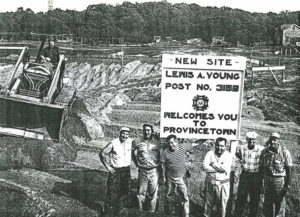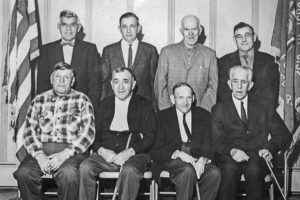
(Photo John D. Bell)
PROVINCETOWN — In the 60 years since the Lewis A. Young V.F.W. Post 3152 was constructed on Jerome Smith Road, how many visitors to Provincetown have turned off Route 6 onto Shank Painter Road, glanced at the building, and wondered who Lewis A. Young was? How many of them knew that Young was a World War I veteran who died in France — not in battle, but because of the 1918 influenza pandemic, which infected one-third of the world’s population and killed an estimated 20 million to 50 million people?
In the 1930s, when charter members of the Veterans of Foreign Wars first organized in the basement of Provincetown Town Hall, they named their post in Young’s honor and memory.
A different kind of corps gathered with tools and know-how in 1959 to raise a building where veterans could come together to share their experiences and enjoy camaraderie. After meeting for years in a school dept.-owned building on Montello Street, Provincetown’s veterans finally had a place to call their own.
Over the front door and on the lawn they proudly placed signs displaying Young’s name, and they filled the simple rooms with memorabilia. The building soon resounded with friendly banter, raffles, and wild games of whist and bingo. The Ladies Auxiliary, the backbone of the post, enthusiastically planned bake sales, holiday parties, and parade floats. The modest building became the tangible expression of V.F.W. values.
Did those passersby know that Lewis’s family roots reached deep into the Provincetown and Truro soil? Did they know that along with his own sacrifice, generations of his extended family had served their country and community?
Lewis Armstrong Young was born in 1896, the son of Provincetown natives William Henry Young (1871-1942) and Anna Morse Hughes (1872-1939), pillars of the community. A banker and founder of an insurance company, William was the first president of the Art Association, president of the Board of Trade, and chairman of the Tercentenary Committee. Both of Lewis A. Young’s grandfathers, Paron Cook Young (1838-1912) and Hezekiah Paine Hughes (1839-1919) were veterans of the Civil War.
Paron, born in Provincetown to Elisha Young and Betsy Sparks, suffered a gunshot wound in the throat during the war and underwent one of the first tracheotomies. He later was appointed Provincetown’s postmaster. He married Susan Johnson (1845-1903), the daughter of merchant Joseph P. Johnson and the niece of Provincetown’s only War of 1812 veteran, Timothy P. Johnson. Through his Cook family line, Paron could trace his ancestry back to Mayflower passenger Stephen Hopkins. Hopkins’s great-great-grandson, Solomon Cook, was the scion of the Cook family in Provincetown and his son, Capt. Solomon Cook (1737-1819), was recently recognized with seven other town fathers as a Patriot of the Revolutionary War.
Hezekiah, born in Truro to John Hughes and Hannah Paine, married Truro-born Orianna Armstrong (1844-1930) on July 26, 1862, just days before his enlistment. She was the daughter of Edward Armstrong, born in France, and Hannah Hopkins, also a Mayflower descendant. Hezekiah, a lieutenant in the Third Massachusetts Calvary, suffered “malarial poisoning” during his three-year enlistment. He received an invalid’s pension and returned to Truro, where he served as keeper of Highland Light before working as a dry goods merchant.
Lewis Armstrong Young followed a proud family tradition of service, enlisting on July 24, 1917, in the U.S. Naval Reserve Force as a machinist’s mate. He was assigned to the U.S.S. Marietta, a schooner-rigged gunboat engaged in convoy duty. On Oct. 15, 1918, he died onboard the Marietta and was buried at Pauillac, France, in a plot assigned to the U.S. Navy. In 1920 he was brought home to Provincetown and buried with full military honors. His younger brother, Arthur Young, a member of the Student Army Training Corps while attending Boston University, was inducted on Oct. 23, 1918, and honorably discharged on December 13, 1918. He died the following June of laryngeal tuberculosis.

Sometime in the next months, Provincetown residents and those still-living veterans who shared friendship and support at V.F.W. Post 3152 will bear witness to a more somber event in the life of the building: not a raising, but a razing, as the building will be torn down to make way for a new venture.
Ground will again be broken, pictures of dignitaries with their shovels will be taken for posterity, and the new construction may be named for someone in the community. Years from now, folks turning off Route 6 onto Shank Painter Road will glance over and perhaps wonder who that someone was and what he or she accomplished.
Without the V.F.W. building on the landscape, the name of Lewis Armstrong Young risks being forgotten unless the town and all those who call Provincetown home make an effort to not forget. Everything stays alive as long as we keep it in our collective memories.



